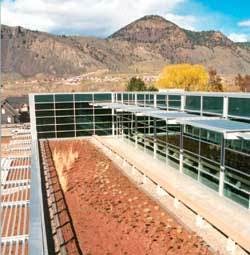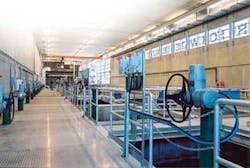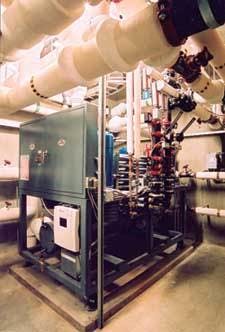Saving Water, Seeing Green: Water Treatment Plant Strives for Sustainability
By Brian Christianson and Reno Fiorante
Sustainability and water conservation have long been hot topics in the water treatment field. Despite the growing awareness of the benefits of sustainability, however, few municipalities in North America have had the resources or regulatory incentives to incorporate sustainable or “green” designs into their infrastructure systems.
But the city of Kamloops, British Columbia, wanted to try - and it worked. The city now boasts the Kamloops Centre for Water Quality, a new membrane drinking water treatment plant that processes over 42 mgd for over 80,000 residents, all while operating with water- and energy-saving systems.
Vision of Sustainability
In the late 1990s, the city had been experiencing problems with turbidity in its unfiltered source and was often forced to issue water quality advisories to residents. Its water treatment facility was built in 1973, using 3-millimeter screening and chlorination to treat water from the South Thompson River. While the river is generally a good quality source, its turbidity levels can reach 500 NTU during spring runoff. The plant’s age and the lack of filtration, coupled with more frequent reports of gastrointestinal cases, prompted the health authority to order the city to build a new water treatment facility.
Early on, the city knew it wanted to build an innovative plant that delivered superior water quality to its residents. In fact, the community was so interested in improving their water that they formed a committee to investigate new and improved alternatives for water treatment before preliminary design of the plant had even begun. Committee members soon learned about the emerging membrane filtration technology and urged the city council to look into it. Taking their cue, the project team established a number of pilot treatment systems to test both membrane and rapid rate filtration. Over the course of the year, the four pilots operated for four to six weeks each season, and the results indicated all systems would meet federal requirements. The team agreed that membrane filtration was a viable treatment technology for Kamloops.
The process works like this: Water from the river is pumped to the single-stage flocculation tanks, where chemicals are added for coagulation. The water then enters the primary membrane tanks, where filtration occurs using immersed membranes. After filtration and chemical conditioning, the water is held in the clearwell/chlorine contact chamber and sent to the main high-lift pumping station for distribution.
A membrane plant produces an unusually high wastewater stream, typically in the order of 8 to 10 percent of the plant’s capacity. This wastewater stream is directed to secondary membrane tanks where the wastewater is reclaimed back into the system at the influent chamber, resulting in a 1-percent overall waste stream. Solids are then removed from the final waste stream and the water is discharged to a constructed wetland.
With the type of treatment process selected, the city and its design engineer, Stantec, began looking into ways to incorporate water- and energy-efficient processes into the system. The city knew it wanted more than a concrete block with equipment in it - it was looking for something unique, something that reflected Kamloops’ forward-thinking attitude. The council ultimately created a vision statement for the project that defined the city’s goal to provide high-quality drinking water from a plant that demonstrates the city’s innovation, incorporates community vision, is economically efficient, and advances the understanding of water treatment, water conservation, and environmental stewardship.
Around this same time, Stantec had become increasingly more involved in the LEED, or Leadership in Energy and Environmental Design, program administered by the US and Canadian Green Building Councils. In this program, buildings and processes are rated on how effectively they conserve resources and promote sustainable practices. While the city was not prepared at that stage to seek LEED certification for the plant, the team realized that the LEED criteria provided a perfect framework for designing a top-notch water treatment plant that also saves the city water, energy, and money.
Green Design
The project team then started designing the plant and determining how to most efficiently incorporate green systems into the building and the treatment process.
“We were looking for free energy sources - how we could recoup energy wasted elsewhere,” said Stantec mechanical engineer Todd McGaw.
Considering the semi-arid climate of Kamloops, the team initially explored solar and wind technologies as potential power sources. But as a municipal project with a municipal budget, these options were ultimately dismissed since the front-end costs were quite high and the systems wouldn’t begin to reap financial benefits for a longer time span than the city could afford.
In the end, the team settled on a number of sustainable processes and technologies that covered site sustainability, water efficiency, energy, materials, indoor environmental quality, and design innovations. The wastewater resulting from the treatment process, for instance, is used to irrigate the landscape surrounding the building and as a heat source through central heating pumps, whose byproducts also heat domestic hot water. The building also uses dual-flush toilets, waterless urinals, electronic sensor faucets, and flow restrictors in showers and sinks.
The wastewater streams are also used to irrigate the building’s green roof, which covers the administrative area of the plant. The building was originally designed to accommodate a green roof over the entire facility, but the city was apprehensive about potential maintenance issues for such a large area. Instead, the city opted to cover only a portion of the building, using this surface as a test green roof to determine the viability of green roof technology for other city buildings and to showcase the technology to visitors.
As for heating, the facility includes a heat recovery ventilation system, which cools the air naturally by passing it through the cooled water membrane filter rooms. The boilers are high-efficiency models, and the heating system has a maximum high water temperature of 130° F. While this type of system is more expensive and requires bigger coils than traditional heating systems, the additional costs are quickly offset by lower operating costs and reduced energy consumption. Heat is recovered from the air blowers, which are used to scour the membranes.
In addition to the energy and water saved through the treatment process, the building and the site themselves showcase green design as well. The plant was built on a former brownfield, which helped preserve undeveloped land in the city. Over 71 percent of the site was restored to provide natural habitat, xeriscaping was used to conserve irrigation water, and the landscape now includes a constructed wetland, a stream, and native plants.
One hundred percent of the regulated electricity in the building’s administration area comes from renewable sources, over 25 percent of the building’s materials are made of recycled products, and over 20 percent were manufactured or harvested locally. The plant even provides preferred parking for bicyclists and employees who carpool, which helps reduce pollution and promote alternative methods of transportation.
Infrastructure for the Future
During the early design stages of the plant, some city staff and other members of the community expressed a few doubts about the efficiency and price of integrating green technology with water treatment. Would the new processes interfere with the treatment system? Are they really worth the added cost?
But combining effective water treatment and efficient system performance came naturally. Since the water treatment process is inherently akin to the closed-loop nature of the sustainability model, it was fairly easy to develop a sustainability strategy for each step of the way. The water treatment process is a cycle - it takes water from its source, processes it, delivers it to the consumer, and then returns the waste to the source. That’s the model of sustainability at work.
And the money saved by these systems in the near future will quickly justify any added initial costs. In fact, with the added green features, the project was still completed within the budget set by the city before sustainability was part of the equation. In addition, energy modeling has shown that the building is saving more than 61 percent of the energy costs of a comparable reference building in the Model National Energy Building Code of Canada.
As the project team moved forward with the design and began realizing these potential savings, they returned to the notion of obtaining LEED certification, targeting a Silver rating. Just last fall, the city was pleasantly surprised with a LEED Gold rating instead, making the plant the first water treatment facility in all of Canada to achieve that level.
As its name implies, the plant has become a center for environmental education and research as well since a local university moved into the ground floor. Working from the classrooms, offices, and laboratory on the floor, the university now researches water quality issues and hosts a water treatment operators’ course.
“When I visit the finished plant,” said Stantec’s design team director Peter Shand, “that’s the area that makes me think we really have something different here, that this was a great idea.”
The Kamloops community, too, has embraced the plant as a symbol of the city’s progressive thinking and commitment to environmental responsibility. Since the plant opened, it has attracted visitors from across the globe hoping to bring its water treatment and sustainable ideas and innovations back to their own communities.
“People have been very happy with it,” Shand said. “The final product has convinced everyone that this is a community achievement to be proud of.”
The Kamloops Centre for Water Quality demonstrates to municipalities everywhere that sustainability is not an extravagance available only to private industry. Rather, it’s a valuable - vital, even - framework around which cities, towns, and nations should begin to revolve.
About the Authors:
Brian Christianson, MAIBC, was the lead architect of the Kamloops Centre for Water Quality project and is managing principal of Stantec’s Kamloops, British Columbia, office. He can be reached at [email protected]. Reno Fiorante, P.Eng, is Vice President of Stantec’s Environmental Infrastructure division and can be reached at [email protected].




